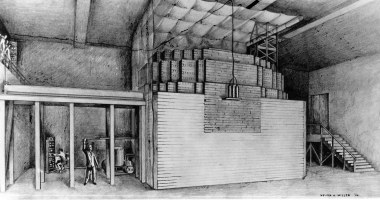Seventy years have passed since a team of 49 scientists, led by Italian-born Enrico Fermi, succeeded in creating the world's first self-sustaining nuclear chain reaction.
 |
| CP-1, with its manually operated control rod (Image: ANL) |
Built upon a squash court in the University of Chicago, the Chicago Pile 1 reactor (CP-1) went critical on 2 December 1942. It consisted of a wooden frame housing graphite layers containing channels that were filled with sintered uranium powder. Control was achieved by hand; a man - George Wile - incrementally withdrawing the control rod as per Fermi's orders until the neutron counters indicated that the reaction was self-sustaining.
By demonstrating that the rate of fission could be controlled, the experiment ushered in the nuclear age. This led initially to the development of weapons and then peaceful applications were developed over the next decade. The Obninsk nuclear power plant in Russia became the world's first civilian power reactor upon its connection to the grid in 1954.
ANL has long tried to dispel the myth that all of the scientists who worked on the pile have died from cancer. They note that 37 of the 49 scientists are known to have died, with age of death recorded for 29. Of these 20 lived to be over 70 years old. Cause of death is known for 27: 11 from heart disease; 5 from strokes, 2 cases of lung disease, 6 cancers unlikely to be caused from radiation, one of Alzheimer's, one from hepatitis and one due to accident.
The Argonne National Laboratory (ANL) published a video in July to commemorate the scientific landmark. Two of the scientists present at the experiment recalled how the discovery of a then entirely new energy source was celebrated with a bottle of Chianti wine, drunk in silence from paper cups.
Warren Nyer reflected "nobody said anything which I thought was a fairly remarkable thing. There was no big hullabaloo of doing something that was truly momentous - given what had taken place there and the implications of what might follow."
There are presently 437 operating nuclear power reactors in the world today. These are located in over 31 countries and supply about 13.5% of world electricity.
Researched and written
by World Nuclear News




_18570.jpg)
_16159.jpg)
_18938.jpg)
_33584.jpg)





